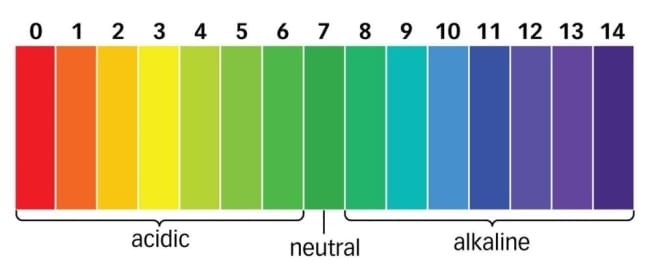The Best Fluffy Pancakes recipe you will fall in love with. Full of tips and tricks to help you make the best pancakes.
Have you ever wondered why some vodkas seem to have a sharper bite than others? It turns out, the culprit might be acidity!
Contrary to popular belief, vodka isn’t always the neutral spirit it’s cracked up to be. Its pH level, a measure of acidity or alkalinity on a scale from 0 to 14 (with 7 being neutral), can vary surprisingly. Its acidity can vary from slightly acidic (around a pH of 6.0-7.0) to even slightly alkaline (up to a pH of 8.8).
This variation can influence not just how smooth a vodka tastes, but also how it interacts with your body, particularly for those who struggle with acid reflux.
What is PH level of Vodka?
Vodka’s pH level isn’t a fixed number, but rather exists on a spectrum, defying its reputation for neutrality. Here’s a breakdown:
Most vodkas fall within a slightly acidic range of 6.0 to 7.0 pH. This is close to neutral, but with a touch more acidity than pure water (pH 7).
Some, particularly cheaper brands, can be more acidic, reaching around a pH of 4. This acidity often comes from additives like citric acid, used to balance flavor or compensate for a harsh taste from less-refined distillation processes.
Surprisingly, some premium vodkas can have a higher pH, reaching near neutral or even slightly alkaline (up to 8.8 pH). This can be due to specific filtration techniques that remove acidic components or the presence of minerals like calcium and magnesium from the water source used in production.

Vodka brands that are acidic(PH below 7)
A liquid is considered acidic if it has a pH level below 7. So, following that rule, any vodka with a pH lower than 7 would be classified as acidic. Most vodkas fall into this category, typically ranging from a slightly acidic pH of 6.0 to 7.0.
Most vodkas are slightly tart, around a 5 or 6. Some are even tangier, like a 4, if they have flavorings added.
Some general indicators can help you identify potentially more acidic vodkas:
Lower priced vodkas: These often use shortcuts in the distillation process or rely on additives to achieve a certain taste. These shortcuts can lead to a higher acidity level.
Brands with a reputation for a harsh bite: While taste can be subjective, some vodkas are known for a sharper taste profile. This could be a sign of increased acidity.
Based on the typical pH range for different vodka types, here’s a breakdown of how acidic Smirnoff, Ketel One, Belvedere, Grey Goose, and Tito’s likely are:
Smirnoff vodka (around pH 6.0): This falls right in the middle of the “slightly acidic” range for vodka (6.0-7.0). It shouldn’t have a particularly sharp bite.
Ketel One (around pH 5.8): Leaning towards the more acidic side of vodkas. It might have a slightly sharper taste due to the lower pH compared to Smirnoff.
Belvedere (around pH 6.4): This is on the less acidic side of the spectrum for vodka. Belvedere might have a smoother taste because of the potentially reduced acidity from filtration.
Grey Goose & Tito’s (around pH 6.2): Both fall within the typical, slightly acidic range for vodka. They likely won’t have a strong acidic bite.
Alkaline Vodka brands (PH above 7)
Look for vodkas that emphasize their use of mineral-rich water sources, particularly those containing calcium and magnesium. Examples include:
FIx High Alkaline Vodka: This Texas-based brand specifically focuses on its high-alkaline properties (around pH 8-9) achieved through mineral water and filtration processes.
Reyka Icelandic Vodka: This brand utilizes volcanic spring water from Iceland, which might contribute to a higher mineral content and potentially a more alkaline profile.
While smoothness doesn’t guarantee alkalinity, some brands known for a smooth taste might have undergone processes that could lead to a slightly higher pH. Explore options like:
Chopin Potato Vodka: Potato-based vodkas like Chopin might naturally have a slightly higher pH compared to grain-based options.
Factors Influencing Vodka’s pH Level and acidity

While vodka often boasts a reputation for neutrality, its acidity level can tell a different story. This variation, measured by the pH scale (ranging from 0-14, with 7 being neutral), can influence not only taste but also how vodka interacts with your body. Let’s delve into the surprising factors that shape a vodka’s pH profile:
Grain Source and Fermentation:
The type of grain used as the base (wheat, corn, potato) and the fermentation process play a crucial role. Grains like wheat naturally introduce lactic acid during fermentation, contributing to a slightly acidic profile (around pH 6.0-7.0).
This acidity, however, might be gentler on the stomach compared to other acidic beverages like wine or beer, making some vodkas a better choice for those with acid reflux.
Explore options like potato vodka (e.g., Chopin) or grape vodka (e.g., Ciroc). These bases might naturally be less acidic than grain-based vodkas.
Distillation Techniques:
The distillation method significantly impacts the level of residual acidity. Traditional methods might leave behind more acidic components, while some modern techniques, like multiple distillations or charcoal filtering, can remove them. This removal can lead to a smoother, less acidic vodka (potentially reaching a higher pH closer to neutral).
Additives and Filtration:
Citric acid, sometimes added for taste or to balance harshness in less-refined vodkas, can significantly lower the pH, making the vodka more acidic (around pH 4).
Conversely, specific filtration methods can remove these acidic components, raising the pH. Additionally, high-end vodkas might utilize mineral-rich water sources (containing calcium and magnesium) that contribute to a more alkaline profile (slightly higher pH, up to 8.8). This alkalinity might even offer benefits for tooth enamel, although more research is needed.
Air Exposure:
Vodka isn’t completely air-tight. Over time, especially if stored for a long time or even when poured, a tiny bit of air can get in. This air contains carbon dioxide, which can slightly increase the acidity of the vodka. Think of it like leaving a soda open for a while – the bubbles slowly escape, making it a touch less fizzy and slightly more acidic.
Aging (if applicable):
Some high-end vodkas are aged in special containers. This aging process can add unique flavors, but it might also affect the acidity a little. Scientists are still figuring out exactly how aging works, and whether it makes the vodka more or less acidic.
Storage Conditions:
While less significant than other factors, long-term storage, especially in hot or fluctuating temperatures, can potentially lead to a slight increase in acidity over time. Think of sunlight spoiling milk – extreme storage conditions can cause minor changes in vodka’s chemistry, including its acidity.
While vodka won’t freeze solid, proper storage is still key! Keep it upright in a cool, dark place away from direct sunlight for the smoothest, most flavorful experience.
Water Source and Mineral Content:
The water used for vodka production plays a surprising role. Imagine water as a blank canvas – the minerals it contains can influence the final pH. High-end vodkas sometimes use water rich in minerals like calcium and magnesium, contributing to a more alkaline profile (slightly higher pH, up to 8.8).
This alkalinity might even offer benefits for tooth enamel, although more research is needed. Conversely, water with fewer minerals can result in a slightly more acidic vodka.
Fermentation Conditions:
Just like baking bread, the specific conditions during fermentation, such as temperature and how long it lasts, can influence the type and amount of acids produced. Think of it like letting dough rise – warmer temperatures or longer fermentation times might lead to a slightly higher acidity level in the final vodka.
It’s important to note that vodka can also be produced from non-grain sources like grapes, potatoes, or even whey. These alternative bases can sometimes naturally result in a less acidic vodka, potentially offering a better choice for those with acid reflux and stomach sensitivities.
Does Vodka’s Acidity Really Matter?
We’ve delved into the surprising world of vodka’s acidity, but does it truly matter when you raise a glass? Here’s a breakdown of how acidity can influence your vodka experience:
Taste and Smoothness:
Acidity can play a role in taste perception. While taste is subjective, some find slightly acidic vodkas (around pH 6.0-7.0) to have a bit of a bite.
Less acidic vodkas (closer to neutral or even slightly alkaline) might be perceived as smoother. However, other factors like quality of ingredients and distillation methods also significantly influence taste.
Impact on Health:
For those with acid reflux or sensitive stomachs, vodka’s acidity can be a deciding factor. Generally, vodka’s acidity is lower than other alcoholic beverages like wine or beer. This can make some vodkas a better choice for people with these conditions.
Additionally, some research suggests that high-pH (slightly alkaline) vodka might offer benefits for tooth enamel, but more studies are needed.
Ultimately, the ideal vodka acidity comes down to your individual taste and health considerations. Experiment with different brands and types of vodka to discover what you enjoy most.
Comparing Vodka’s Acidity to other alcohols
Vodka might surprise you! It’s generally less acidic than other boozy drinks.
Vodka (pH 6.0-7.0): Most vodkas fall within this slightly acidic range, offering a subtle tang. Some may be even closer to neutral (pH 7).
Wine (pH 3.0-4.0): Wines tend to be significantly more acidic than vodka. This acidity contributes to the distinct flavors of different wine varietals. Red wines generally have a higher pH (less acidic) than white wines.
Beer (pH 4.0-5.0): Beers also tend to be more acidic than vodka. The specific type of beer and the brewing process can influence the final pH level. Lagers typically have a higher pH (less acidic) compared to ales.
If you experience acid reflux or have a sensitive stomach, vodka might be a better choice compared to wine or beer due to its lower acidity.
Conclusion
So, Vodka can be acidic! Most vodkas range from slightly acidic (pH 6.0-7.0) to neutral (pH 7).
Several factors influence acidity, like grain source, distillation methods, and even water source. While most vodkas fall within this range, some can be more acidic (around pH 4) or even slightly alkaline (up to pH 8.8).
FAQS
Which alcohol is most acidic?
Out of the common alcoholic beverages, wine takes the crown for being the most acidic. Wines typically range from a pH of 3.0 to 4.0 on the pH scale, which leans towards the acidic side. This acidity is a key player in a wine’s taste and aroma, influencing flavors like citrus, tartness, and even some richer notes like plums.
While other alcoholic beverages can be acidic too, like beers (pH 4.0-5.0), they generally fall within a less acidic range compared to most wines.
Which is more acidic, vodka or wine?
When comparing vodka and wine, wine is definitely the more acidic beverage. Wines typically range from a pH of 3.0 to 4.0, while vodka falls within a slightly acidic to neutral range (pH 6.0-7.0). This means vodka has a noticeably less tart or acidic taste compared to wine.
Is vodka highly acidic?
No, vodka is generally not highly acidic. Most vodkas fall within a slightly acidic to neutral range (pH 6.0-7.0) on the pH scale. This means they have a less tart or acidic taste compared to beverages like wine or beer. While some vodkas might be closer to neutral (pH 7), they typically still offer a subtle tang.
Think of it like this: a slightly tart apple (around pH 6) is a good comparison for vodka’s acidity level.
Which vodka is high alkaline?
Unfortunately, there’s no single “high alkaline” vodka brand due to limited availability and brand secrecy. Some vodkas, however, might have a slightly higher pH (more alkaline) than others. These potentially higher-alkaline options often focus on mineral-rich water sources or specific filtration processes.
Examples include FIX High Alkaline Vodka (around pH 8-9) or Reyka Icelandic Vodka (utilizes volcanic spring water).
Why is vodka alkaline?
Most vodkas are not actually alkaline (higher than pH 7). However, some vodkas might have a slightly higher pH due to specific factors like:
- Mineral-Rich Water Source: Using water rich in minerals like calcium and magnesium can contribute to a more alkaline profile (up to pH 8.8) in some vodkas.
- Filtration Processes: Certain filtration methods might remove acidic components, potentially leading to a slightly higher pH level in the final vodka.
Is vodka bad for gastric?
Vodka’s generally lower acidity compared to other alcoholic beverages (like wine or beer) might make it a better choice for those with gastric issues like heartburn or acid reflux. However, alcohol itself can irritate the stomach lining, so moderation is key regardless of the specific drink.
Which is more acidic vodka or whiskey?
In general, whiskey is more acidic than vodka. Whiskies typically have a pH of around 4.2, which leans towards the acidic side. This acidity can contribute to some of the distinct flavors associated with whiskey, like peppery notes or a slight bite.









